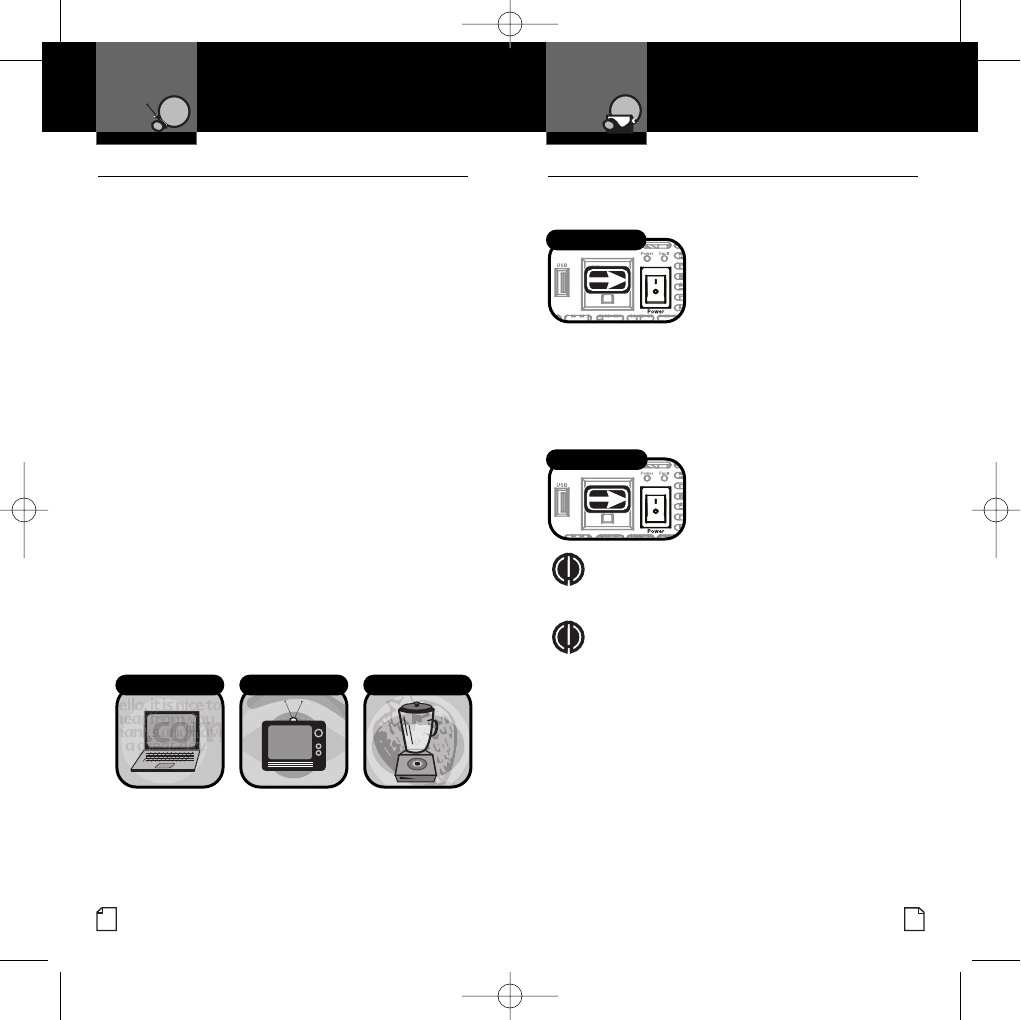
11
10
Turning Your Inverter On or Off
•
Be sure to have your power inverter properly installed before
attempting to turn the unit on (see installation page 5).
To turn the power inverter on:
1.If a DC power supply is being
used as the power source, switch
it on.
2.On the left side panel, switch the
On/Off Switch to on.
The inverter is now ready to deliver AC power to your loads.
If several loads are to be operated by the inverter, turn them
on separately, after the inverter has been turned on. This
will ensure that the inverter does not have to deliver the
starting currents required for all the loads at once.
To turn the power inverter off:
1.
On the left side panel,
switch the On/Off Switch
to off.
NOTE The On/Off Switch turns the control circuit
in the inverter on and off. It does not disconnect
power from the inverter.
NOTE When the switch is in the off position, the
inverter draws no current from the battery. When
it’s in the
on position, but no power is being
supplied to the load, the inverter draws less than
500 milliamperes from the battery. This is low
current draw. It would take more than a week to
discharge a 100 ampere-hour battery at this rate
depending on the age of the battery.
Power Consumption
Intro Operation Customer
Assistance
Warranty
N
otes
Notice
Secondary Icons
Caution Warning
Installation
Installation
Power On and Off
I
ntro Operation Customer
Assistance
W
arranty
Notes
Notice
Main Icons
Secondary Icons
Caution Warning
I
nstallation
Operation
I
ntro Operation Customer
Assistance
W
arranty
Notes
Notice
Main Icons
Secondary Icons
Caution Warning
Installation
I
ntro Operation Customer
Assistance
W
arranty
Notes
Notice
M
ain Icons
Secondary Icons
Caution Warning
I
nstallation
Nothing Comes Close to a Cobra
®
Power Consumption
•
For each piece of equipment you will be operating from the
inverter, you must determine the battery’s reserve capacity
(how long the battery can deliver a specific amount of
current – in automotive batteries, usually 25 amperes) or
ampere-hour capacity (a measure of how many amperes
a battery can deliver for a specified length of time).
Example – Reserve capacity: a battery with a reserve
capacity of 180 minutes can deliver 25 amperes for
180 minutes before it is completely discharged.
Example – Ampere-hour capacity: a battery with an
ampere-hour capacity of 100 ampere-hours can deliver
5 amperes for 20 hours before it is completely discharged.
To determine the battery ampere-hour
capacity you require:
1. Determine how many watts each piece of equipment
consumes. This can normally be found on the product
label. If only the current draw is given, multiply the
current draw by 115 to get the watt consumption.
2. Estimate the time (in hours) that each piece of equipment
will be running between battery charging cycles.
3. Calculate the total watt-hours of energy consumption
(power x operating time) using the average power
consumption and the total estimated running time
(in hours). Power x Operating Time = Watt-Hours.
4. Divide the watt-hours by 10 to determine how many
power supply’s (12 volt) ampere-hours will be consumed.
On/Off Switch to On
I
ntro Operation Customer
Assistance
W
arranty
Notes
N
otice
Main Icons
Secondary Icons
C
aution Warning
I
nstallation
On/Off Switch to Off
I
ntro Operation Customer
Assistance
W
arranty
Notes
Notice
Main Icons
Secondary Icons
Caution Warning
Installation
Laptop
50 watts x 2 hours
= 100 watt-hours
TV/VCR (up to 25")
115 watts x 3 hours
= 345 watt-hours
Blender
300 watts x 15 minutes
= 75 watt-hours
10273_CPI875_PH2 7/10/07 6:04 PM Page 10













